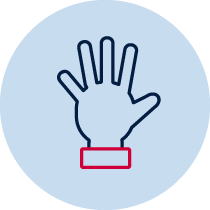3D shape – sort and classify
Students sort and classify a selection of 2D shapes and, or 3D objects, providing reasoning as to why the shapes and objects have been sorted and classified in that way
 |
 |
|
 |
| Practical | Resources required | Take a photo | Collaborative |
Measurement and geometry – 3D space
- describes mathematical situations and methods using everyday and some mathematical language, actions, materials, diagrams and symbols MA1-1WM
- uses objects, diagrams and technology to explore mathematical problems MA1-2WM
- supports conclusions by explaining or demonstrating how answers were obtained MA1-3WM
- sorts, describes, represents and recognises familiar three-dimensional objects, including cones, cubes, cylinders, spheres and prisms MA1-14MG
Content
3D space
Recognise and classify familiar three-dimensional objects using obvious features (ACMMG022)
Describe the features of three-dimensional objects (ACMMG043)
- Explain the attribute or multiple attributes used when sorting three-dimensional objects (Communicating, Reasoning)
National Numeracy Learning Progression mapping to the NSW Mathematics syllabus
When working towards the outcome MA1-15MG the sub-elements (and levels) of Interpreting fractions (InF1) and Understanding geometric properties (UGP2-UPG4) describe observable behaviours that can aid teachers in making evidence-based decisions about student development and future learning.
Materials
- 3D objects, including real-life objects, such as tissue boxes and glue sticks (or images of 3D objects)
- 2D pattern blocks (or images of 2D shapes)
- Whiteboards/paper
Teacher instructions
Students will sort and classify a selection of 2D shapes and/or 3D objects, providing reasoning as to why the shapes/objects have been sorted and classified in that way (For example, students may group a square, rectangle, prism and cube together and justify this choice by explaining that all shapes and objects have 2D shapes with 4 sides and 4 vertices). It is likely there will be a range of responses which provide an opportunity to assess student reasoning and communicating proficiencies. Possible prompts or adaptations could include ‘What is the same and what is different about these objects/shapes?’, ‘Which one doesn’t belong and why?’
Possible student classifications could include:
- prisms / non-prisms
- curved surface / flat surface
- faces / circular surfaces
- can roll / can't roll
- symmetrical/non-symmetrical
- vertices/ no vertices
Students should be able to communicate using the following language – object, shape, two-dimensional shape (2D shape), three-dimensional object (3D object), cone, cube, cylinder, sphere, prism, surface, flat surface, curved surface, face, edge, vertex (vertices).
Note – In geometry, the term 'face' refers to a flat surface with only straight edges, as in prisms and pyramids, eg a cube has six faces. Curved surfaces, such as those found in cones, cylinders and spheres, are not classified as faces. Similarly, flat surfaces with curved boundaries, such as the circular surfaces of cones and cylinders, are not faces
The term 'vertex' (plural: vertices) refers to the point where three or more faces of a three-dimensional object meet (or where two straight sides of a two-dimensional shape meet).
In geometry, the term 'edge' refers to the interval (straight line) formed where two faces of a three-dimensional object meet.
Enabling prompts
If there are students who are unable to sort and classify 2D shapes and 3D objects and provide reasons for their choice, focus just on 2D shapes or 3D objects. If necessary provide students with a range of possible classifications and ask them to sort the objects.
Extending prompts
- What is the same and what is different about these objects/shapes?
- Which one doesn’t belong and why
- Is there another way that you could sort these objects/shapes? How do you know?
- How many ways can you sort those objects/shapes? How do you know?
Student instructions
Sort and classify a selection of 2D shapes and/or 3D objects, providing reasoning as to why the 2D shapes and/or 3D objects have been sorted and classified in that way.
Possible areas for further exploration
- mathematical language used to classify shapes and describe attributes of objects
- ability of students to determine the difference between a side and a face or surface
- level of understanding of 3D object properties to give reasons as to the similarities or differences between them.
Where to next?
- drawing and labelling, or filling out a table of attributes for the 3D objects, labelling and/or pointing out the similarities and differences between a variety of 3D objects
- show their understanding by drawing or writing in a Venn diagram.
Adapted from ‘Open-Ended Maths Activities’ - Peter Sullivan and Pat Lilburn 2017
Syllabus
Please note:
Syllabus outcomes and content descriptors from Mathematics K-10 Syllabus © NSW Education Standards Authority (NESA) for and on behalf of the Crown in right of the State of New South Wales, 2012
